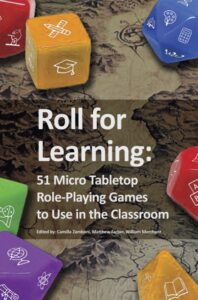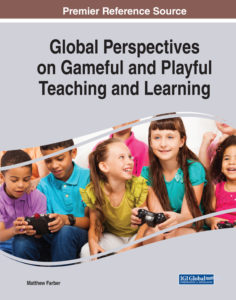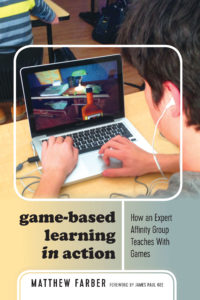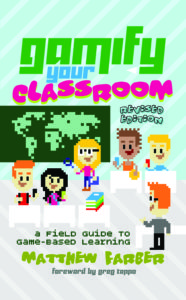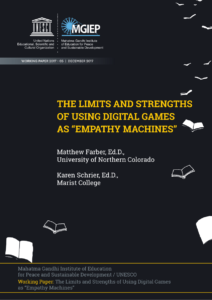
Matthew Farber, Ed.D. is Associate Professor of Educational Technology and Codirector of the Gaming SEL Lab at the University of Northern Colorado. He is a play theorist who studies how games can foster empathy, compassion, perspective-taking, and ethical decision-making. He was a contributing writer for Origin101, the official learning companion for Ava DuVernay’s critically acclaimed film Origin. Author of several books and articles, Dr. Farber writes for Edutopia, has been invited to the White House and to keynote for UNESCO, and has been interviewed by NPR, The Washington Post, APA Monitor on Psychology, EdSurge, The Denver Post, Fast Company, USA Today, and The Wall Street Journal. He has codeveloped game-based lessons with Tracy Fullerton for her award-winning Walden, a game EDU. In The Well-Read Game: On Playing Thoughtfully, Fullerton and Farber explore how personal and subjective meanings are evoked through a new theory of player response.
The Well-Read Game: On Playing Thoughtfully (The MIT Press, March 25, 2025)
In The Well-Read Game, Tracy Fullerton and Matthew Farber explore the experiences we have when we play games: not the outcomes of play or the aesthetics of formal game structures, but the ephemeral and emotional experiences of being in play. These are the private stories we tell ourselves as we play, the questions we ask, and our reactions to the game’s intent. These experiences are called “readings” because they involve so many of the aspects of engaging with literary, cinematic, and other expressive texts. A game that is experienced in such a way can be called “well-read,” rather than, or as well as, “well-played,” because of the personal, interpretive nature of that experience and the way in which it relates to our reading of texts of all kinds.
The concept of the “well-read game” exists at the convergence of literary, media, and play theories—specifically, the works of Louise Rosenblatt’s reader-response theory, Brian Upton’s situational game theory, Tracy Fullerton’s playcentric design theory, and Bernie DeKoven’s well-played game philosophy. Each of these theories, from their own perspective, challenges notions of a separate, objective, or authorial meaning in a text and underscores the richness that arises from the varied responses of readers, who coauthor the meaning of each text through their active engagement with it. When taken together, these theories point to a richer understanding of what a game is and how we might better value our experiences with games to become more thoughtful readers of their essential meanings.
https://www.thewellreadgame.com/
Roll for Learning: 51 Micro Tabletop Role-Playing Games to Use in the Classroom (Play Story Press, 2024)
Roll for Learning: 51 Micro Tabletop Role-Playing Games to Use in the Classroom is an edited book featuring a curated collection of original micro tabletop role-playing games (TTRPGs). Micro TTRPGs have grown in popularity in recent years, particularly in the game jam space, and offer great potential for classroom use, as these games are intended to be easy to learn and quick to play. Further, TTRPGs are also an emerging field in scholarly texts, so there is a rich literature to draw from when introducing them to instructors.
This volume brings together scholars and instructors working on TTRPGs and game designers with an interest in education. It includes 51 game chapters, each composed of an original micro TTRPG followed by tips for implementation, ideas for assessment, best practice recommendations, and a relevant bibliography—all aligned to learning outcomes for elementary through higher education classrooms.
By focusing on the micro TTRPG model, which is quick to read and easy to implement, this volume creates a space that is at once informed by research, aligned with new trends in the TTRPG world, and welcoming to new interested users. We hope that you will enjoy reading and using Roll for Learning—an educational book you can play!
Gaming SEL: Games as Transformational to Social and Emotional Learning (Peter Lang, 2021)
Games enable children to practice emotions in spaces that are free from actualized consequences. With thoughtful guidance, games can help children manage emotions, perspective-take, demonstrate empathic concern, and exhibit prosocial behaviors.
Emerging research suggests that these competencies—also known as social and emotional learning (SEL) skills—are, in fact, teachable. In Gaming SEL: Games as Transformational to Social and Emotional Learning, Matthew Farber investigates the rich opportunities games have in supporting SEL skill development. Experts from the fields of education, game development, and SEL—including folks from CASEL, the Fred Rogers Center, Greater Good in Education, iThrive Games, Minecraft Education, and UNESCO MGIEP—share advice.
Games themselves cannot be responsible for children’s learning. Having a supportive educator or caregiver guiding experiences can be crucial. This book also includes recommendations for embedding games in classrooms in ways that support meaningful SEL skill development. Regardless of your experience, content area, or grade level, this book is for you!
Global Perspectives on Gameful and Playful Teaching and Learning (IGI-Global, 2020)
In the fast-changing field of education, the incorporation of game-based learning has been increasing in order to promote more successful learning instruction. Improving the interaction between learning outcomes and motivation in games (both digital and analog) and promoting best practices for the integration of games in instructional settings are imperative for supporting student academic achievement.
Global Perspectives on Gameful and Playful Teaching and Learning is a collection of innovative research on the methods and applications that explore the cognitive and psychological aspects underpinning successful educational video games. While highlighting topics including nontraditional exercise, mobile computing, and interactive technologies, this book is ideally designed for teachers, curriculum developers, instructional designers, course designers, IT consultants, educational software developers, principals, school administrators, academicians, researchers, and students seeking current research on the design and integration of game-based learning environments.
Game-Based Learning in Action: How an Expert Affinity Group Teaches with Games (Peter Lang, 2018)
How are expert educators using games in their classrooms to give students agency, while also teaching 21st-century skills, like empathy, systems thinking, and design thinking? This question has motivated Matthew Farber’s Game-Based Learning in Action: How an Expert Affinity Group Teaches with Games showcasing how one affinity group of K12 educators—known as “The Tribe”—teaches with games. They are transformational leaders outside the classroom, in communities of practice. They mentor and lead newcomers to game-based learning, as well as advise game developers, academics, and policymakers. Teachers in “The Tribe” do not teach in isolation—they share, support, and mentor each other in a community of practice. Farber shares his findings about the social practices of these educators. Game-Based Learning in Action details how the classrooms of expert game-based learning teachers function, from how they rollout games to how they assess learning outcomes.
There are plenty of lessons to be learned from the best practices of expert educators. These teachers use games to provide a shared meaningful experience for students. Games are often the focal point of instruction. Featuring a foreword from James Paul Gee—Mary Lou Fulton Presidential Professor of Literacy Studies, and Regents’ Professor—Farber comments on promises and challenges of game-based learning in 21st-century classrooms. If you are looking to innovate your classroom with playful and gameful learning practices, then Game-Based Learning in Action is for you!
Gamify Your Classroom: A Field Guide to Game-Based Learning — Revised Edition (Peter Lang, 2017)
This completely revised and expanded field guide is packed with new innovative ideas on how to implement game-based learning and gamification techniques in everyday teaching. With nearly two dozen more experts than the first edition, this book contains interviews with more than 70 authorities in the field, including academics such as James Paul Gee, Kurt Squire, Mizuko (Mimi) Ito, Lee Sheldon, Jordan Shapiro, and Mary Flanagan. The author also shares conversations with experts from numerous organizations such as Common Sense Media, iCivics, DragonBox, Connected Camps, GlassLab Games, Schell Games, Institute of Play, Games for Change, BrainPOP, Tiggly, Toca Boca, ThinkFun, BrainQuake, Filament Games, BreakoutEDU, Kahoot, Classcraft, and more. Featuring a new introduction, as well as a foreword from USA Today’s national K-12 education writer Greg Toppo, this book provides new practical lesson plan ideas, ready-to-use games, and links for further research in each updated chapter. Included are best practice recommendations from star game-based learning teachers, including Steve Isaacs, Peggy Sheehy, Michael Matera, Rafranz Davis, Zack Gilbert, and Paul Darvasi. Regardless of your teaching discipline or grade level, whether you are new to game-based learning or if you have experience and want to take a deeper dive, this book will engage and reinvigorate the way you teach and how your students learn!
The Limits and Strengths of Using Digital Games as “Empathy Machines” (UNESCO MGIEP, 2017)
Co-authored with Karen Schrier, Ed.D., this UNESCO MGIEP working paper grapples with questions related to the intersection of digital games and empathy. Many people are playing games—but are they also engaged in empathy-related skills such as perspective-taking, communication, reflection, relationship-building, and choice-making as part of their game playing? Are games “empathy machines” that support greater insight into our human condition? In this paper, we seek to (1) identify strengths and weaknesses of games in relation to empathy, (2) consider how player agency, transportation, perspective-taking, communication, and other factors may affect the practice of empathy, and (3) develop initial questions, guidelines, and recommendations for creating policies and programs around using games to inspire empathy.

